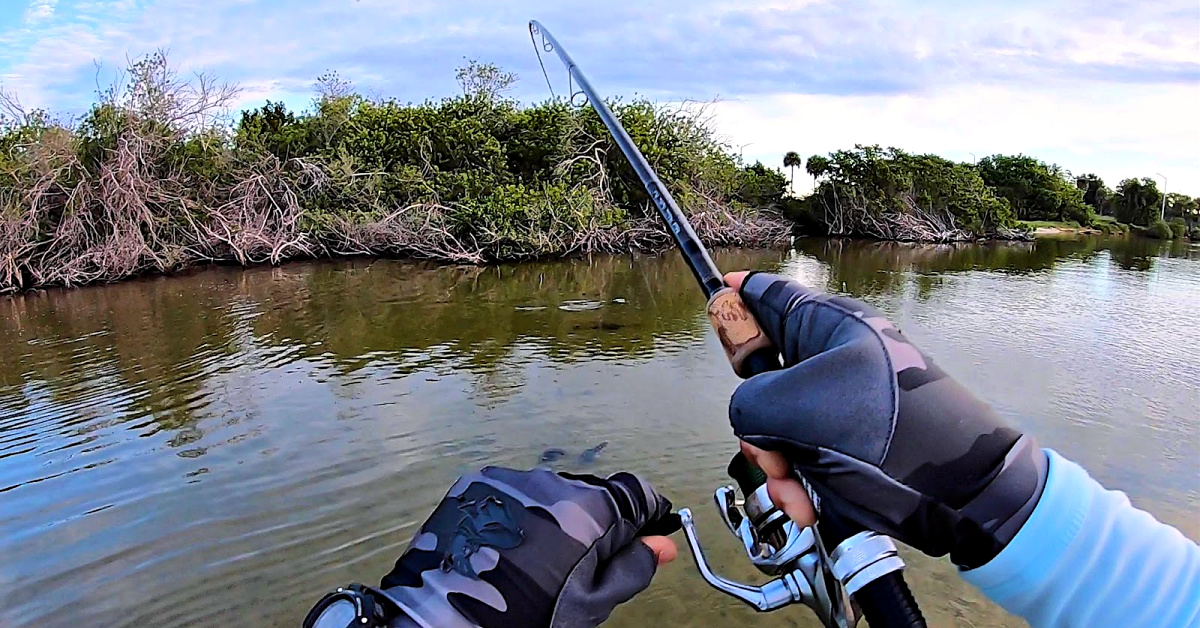#1 Artificial Lure Mistake That Will Cost You Strikes (Underwater Analysis)
- By: Tony Acevedo
- on

Are you making this common mistake when casting out your artificial lures?
How much of an impact does the timing of closing your bail have on your lure presentation?
Learn how to eliminate this mistake from your techniques when using artificial lures!
Check out more here!!
#1 Artificial Lure Mistake That Will Cost You Strikes [VIDEO]

Equipment Used:
- Alabama Leprechaun Jerk Shad
- 3/0 Owner Weighted Twistlock Hook 1/8 ounce
- 10lb Power Pro
- 20lb Business End (Berkley Vanish Fluorocarbon)
Closing your bail too early on your reel can pull your lure out of the target zone too fast where fish won’t strike the lure.
What many anglers do not realize is that if you close the bail immediately when your lure hits the water, your lure is going to swing away from fish or structure you were targeting.
There is a severe discrepancy between closing your bail immediately and letting your lure free line.
Further, this could mean the difference between catching a fish or missing out on strikes.
This common mistake can also apply to live bait or cut bait.
If you do not let your lure or bait sink to the bottom, you are missing out on fish and your intended target zone by closing the bail too soon.
Underwater Analysis
In this underwater demonstration, the pole in the water represents a structure of some kind like a tree branch or dock.
The first trial is casting the lure at the structure and leaving the bail open until the lure sinks to the bottom.
You will notice the lure falls along the structure to the bottom and falls right into the strike zone.
The next trial shows the biggest mistake anglers make when casting out their lures.
That is, of course, slapping your bail closed immediately when the lure hits the water.
If you close your bail too early or reel in line too soon, this will tighten up your line.
When you tighten the line on your lure, you will notice the lure pendulums or swings away from the intended structure.
You can find yourself missing out on a lot of fish because your lure is out of the strike zone.
Fish will hold close to structures for safety reasons and ambush attacks.
As a result, fish do not want to travel too far from that structure to attack a potential meal.
Moreover, the distance your lure will typically swing away from the structure or intended target is about the same as the depth of the water.
Bottom line, you want to keep the tension off of the spool and let the line out so your lure can properly sink to the bottom.
Make sure you are watching your line as the lure is sinking because if you see the line jump or pop, that means a fish struck the lure.
Your line may change directions or the line may be flying off the spool and both of these examples indicate a fish ate your lure.
Do you have any other questions about common artificial lure casting mistakes?
Let me know down in the comments!
And if you know someone who wants to learn the #1 artificial lure mistake anglers make, please TAG or SHARE this with them!
P.S. – Want to make explosive, perfect, and masterful casts with your spinning rod, to reach the trophy fish that have no idea you are there… to cast like the pros, all while using less effort than ever before? Check out Casting Mastery.
Related Articles:
Related categories:
STOP WASTING TIME ON THE WATER!
Do what the “SMART ANGLERS” are doing and join the Insider Club.
Here’s what you’ll receive today when you join:
- Weekly fishing reports and TRENDS revealing exactly where you should fish every trip
- Weekly “spot dissection” videos that walk you through all the best spots in your area
- Exclusive fishing tips from the PROS you can’t find anywhere else
- Everything you need to start catching fish more consistently (regardless if you fish out of a boat, kayak, or land).










Regarding this being the #1 Artificial Lure Mistake That Costs You Strikes? I certainly can think of a lot more mistakes for sure, and the math doesn’t add up for this scenario to make it #1 even if you are fishing deeper water.
The math: A 6’ deep pool and a 20’ max flip, sure you’ll get the results shown in the video. However, a 50’ + plus cast towards some mangroves in water any where from 6” – 24” you shouldn’t have any discrepancy. The amount of braid left in the air after the lure hits the water more than makes up for any “pulling” of lure away from your target.
For me closing the bail means having my reel hand cupped and ready to control the lure placement and amount of “excess” line between the lure and the bail.
Why do we feather the line and close the bail? Wind knots, lure placement, and the immediate strike.
I suppose in the end it’s what works best for you but I bet you in shallow water that lure is already on the bottom before you grab the reel handle.
A ton of variables can come into play, far more than I could talk about in one video.
The main purpose of this video is to simply demonstrate what can happen when your lure lands in the water when closing the bail vs. not closing the bail.
Great point Tony I believe everyone has made this simple mistake because we all want to catch fish NOW but if we slow down especially now since it’s getting colder the results I’m sure would improve because like you said the bait or lure is going to be in the strike zone the longest thus giving the fish more opportunity to see it and strike it thanks for this and all you do😊👍
Thank you for the great feedback Steven! Patience is key!
Thanks Tony
You’re welcome Jerry!
Thanks Tony- I must admit I am guilty especially when casting towards mangroves.
There is a fine line between finding your lure in the mangrove branches or just in
front of the mangrove. I try and skip a lure in pockets and have been known to over cook the cast. Guess I need practice.
Yes when casting to visible structure like trees and mangroves it’s best to practice feathering the line as it gets close to the structure. Just using your finger against the spool to slow the line down, and then letting the lure sink freely after it hits the water.
I have been closing the bail after the lure hit the water in case of an immediate strike HOWEVER what you demonstrated makes total sense! I will let lure descend while “cupping” the spool till lure has made it to the bottom! Thanks Tony! Keep those tips coming!
Great feedback Bob! Yep just keep an eye on your line and it just takes a split second to snap the bail shut, pick up slack and set the hook. Another reason why I like reels with a high gear ratio.
Great information to keep in my mental tackle box.
For sure!
You failed to mention factoring in the speed of the wind. It’s hard enough to control your line when you close the bale. By leaving it open your line balloons way out when it’s windy. You have to reel in all the extra slack.
Hey Rick!
Yes there are many other variables that will come into play. The wind itself can grab your line and cause it to pull your lure away from the structure, and even the current will do the same. Positioning accordingly is key!
I think this tip/topic needs to be added to one of the core courses (maybe Positioning and Approach or even Casting Mastery?) that you recommend people watch first after becoming an Insider Member. This one thing slowed me down a lot even after I went through the Finding Spots and Positioning and Approach courses.
I sort of figured it out on my own then also watched the Fishing Inshore Structure course by Peter Deeks which reinforced the concept.
P.S. Love what you guys are doing, I’ve learned a ton and fishing is a lot more fun, I think I’ve been skunked once in the last two years and it’s been over a year since that happened. I’ve also caught my PB Snook and Trout using the concepts learned in the Salt Strong Coursework. Fishing is now what I always hoped it would be when I first started about 3 1/2 years ago!
Awesome feedback Luke! Thank you for the continued support!
Hey Tony………I’m afraid your recommended practice would result in more line foul ups on the reel. It’s pretty much standard practice to close the bail just before the lure hits the water.
Thank you for the great feedback Gary!
How you manage the line when keeping the bail open is definitely important. I typically feather the line to slow it down before it hits the water. Once the lure lands you can then let if free fall, close the bail, and then make sure the line is snug before retrieving.
Great tip/video Tony! Serves as a good reminder for me as I frequently overlook it. Thanks
Thank you for the great feedback Harry!